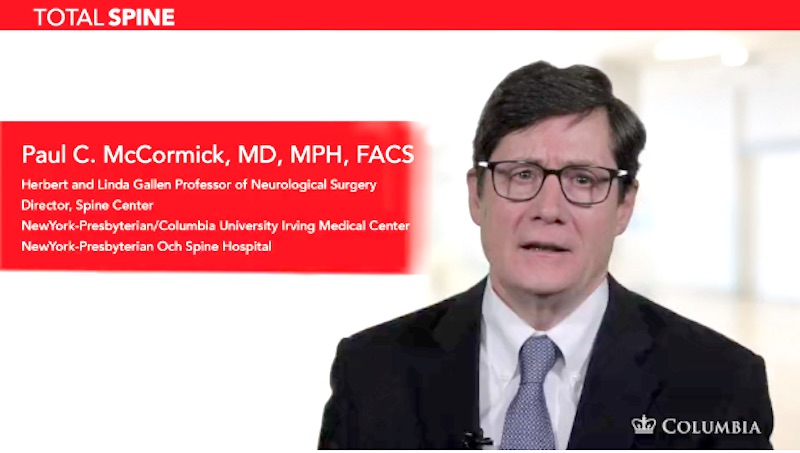| Summary | Schwannomas are nerve sheath tumors, or tumors that originate from the layer of insulation that surrounds nerve fibers. At The Spine Hospital at the Neurological Institute of New York, we specialize in treating spinal schwannomas.
Schwannomas arise from Schwann cells. These cells produce an insulating sheath surrounding the nerve fibers. The Schwann cells manufacture the nerve sheath out of myelin, a substance they produce for that purpose. Schwann cells don’t exist in the spinal cord. They produce their myelin sheath only for nerves outside the brain and spinal cord, called peripheral nerves.
Spinal schwannomas, then, do not arise in the spinal cord itself–there are no Schwann cells there. Instead, schwannomas arise on the spinal nerve roots. These are the nerves that branch out from the spinal cord to connect it with the rest of the body.
Spinal schwannomas are classified into four types by their size, location, and relationship to the dura (a thin membrane that encloses the spinal cord, parts of the spinal nerves, and the spinal fluid within the spinal canal).
- Type I: located entirely within the dura. Most spinal schwannomas are Type I.
- Type II: this tumor began as a Type I tumor, growing within the dura. The tumor then followed the course of the spinal nerve and exited the spinal canal through the neural foramen, the channel through which nerves exit the spine and travel to the body. Type II tumors therefore have two separate tumor components, one inside and one outside the spinal canal, connected through the narrow opening of the foramen. These are referred to as dumbbell-shaped tumors.
- Type III: located entirely outside the spinal canal. These are also called paraspinal nerve sheath tumors.
- Type IV: this tumor began as a Type III tumor, growing outside the spinal canal. It followed the course of the spinal nerve and entered the spinal canal through the foramen. Like Type II tumors, Type IV tumors are dumbbell-shaped.
Schwannomas are typically slow growing and usually benign–that is, they usually are not cancerous and will not spread. Malignant (cancerous) schwannomas are very rare.
Schwannomas are also called neuromas, neurilemomas, and neurinomas.
|
| Symptoms | Small schwannomas often produce no symptoms. When present, symptoms of small schwannomas may include intermittent pain in the area supplied by the nerve that gives rise to the tumor.
More commonly, symptoms don’t begin until the tumor’s significant size puts pressure on the nearby nerves or spinal cord. This pressure may cause pain, numbness, or weakness in the affected limbs, difficulty with balance, or lack of coordination with the hands. In some patients, back or neck pain that awakens them at night–so-called night pain–may be an early or characteristic complaint.
|
| Causes and Risk Factors | Inherited conditions called Neurofibromatosis II (NF2) and Schwannomatosis can cause schwannomas.
Patients without NF2 or Schwannomatosis are said to have “sporadic” schwannomas, and these occur without any known risk factors. Men and women are equally affected. Most occur in the middle decades of life, although they may occasionally occur in children and in older patients. Sporadic nerve sheath tumors are usually solitary in their occurrence–that is, a patient with one sporadic schwannoma is unlikely to develop another one. Sporadic schwannomas are by far the most common type of nerve sheath tumor.
|
| Tests and Diagnosis | Imaging studies usually provide the diagnosis of spinal schwannomas. Magnetic resonance (MR) scans, for example, use magnets, radio waves, and computer technology to produce images of organs and tissues like the brain and spinal cord. MR scans can identify spinal schwannomas as small as a few millimeters.
MR scans are sometimes performed using a contrast-enhancing agent–a material like a dye that makes some tumors light up brightly. The contrast-enhancing agent is delivered intravenously (through an IV) before the MR scan is performed. Most schwannomas enhance with contrast administration. Other intradural tumors, such as meningiomas and myxopapillary ependymomas, may have a similar appearance to schwannoma on MR imaging.
|
| Treatments | The treatment of spinal schwannomas depends on the size, location, and symptoms of the tumor. Small tumors producing no pressure on nearby tissues in patients with no symptoms can often be observed over time with intermittent MR scans.
For larger or symptomatic tumors, or tumors showing growth over time, microsurgical removal is usually recommended. In most patients, complete removal of these tumors can be safely achieved using a surgical microscope, very fine instruments, and an array of microsurgical techniques. In many cases, patients experience an improvement in neurological function.
See Dr. McCormick performing the procedures in the videos below.
Microsurgical resection of cauda equina schwannoma with nerve root preservation
In some patients with large dumbbell tumors, spinal stabilization and fusion may be performed following complete tumor removal.
Resection of a cervical dumbbell schwannoma with stabilization
|


